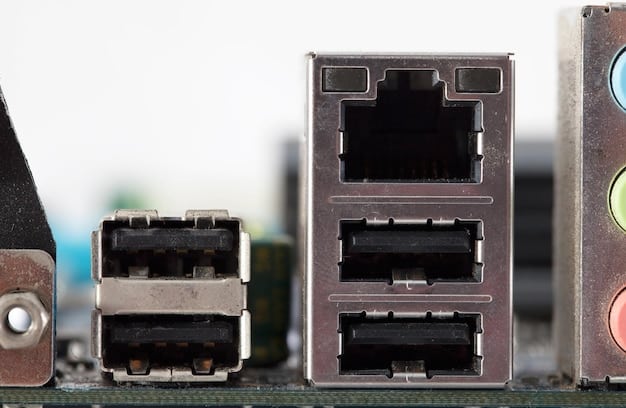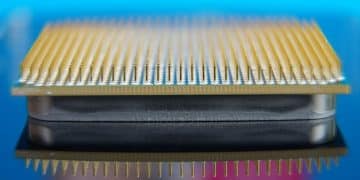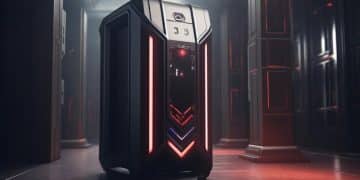Triple Your Frames: Optimize Monitor Refresh Rate Now

Optimizing your monitor’s refresh rate is crucial for competitive gaming, directly enhancing visual fluidity, reducing input lag, and significantly improving player performance by delivering a clearer, more responsive, and immersive gameplay experience.
To dominate competitive gaming, every millisecond and every visual detail count. Understanding how to achieve Triple Your Frames: The Ultimate Guide to Optimizing Your Monitor’s Refresh Rate for Competitive Gaming is not just an upgrade; it’s a fundamental shift in your gaming experience. This guide will walk you through the essential steps to unlock your monitor’s full potential, ensuring you stay ahead of the competition.
The Science of Smooth: Understanding Refresh Rate for Gamers
Understanding refresh rate is foundational to optimizing your gaming setup. It’s not merely a technical specification; it profoundly impacts how you perceive and interact with games. A higher refresh rate translates directly into a smoother, more responsive visual experience, which is paramount in competitive gaming scenarios.
Refresh rate, measured in Hertz (Hz), represents how many times per second your monitor can draw a new image. For competitive gamers, this directly affects reactivity and visual clarity during fast-paced action. The difference between 60Hz and 144Hz, or even 240Hz and beyond, is often described as night and day, transforming blurry motion into crisp, discernible movements.
What is Refresh Rate and Why Does it Matter?
Many gamers operate under the assumption that a powerful GPU automatically translates into a superior visual experience. While the GPU renders the frames, the monitor’s refresh rate dictates how many of those frames are actually displayed per second.
- Enhanced Responsiveness: Higher refresh rates reduce input lag, allowing your actions to be reflected on screen almost instantaneously. This is critical in games where split-second decisions determine victory or defeat.
- Improved Visual Clarity: Motion blur is significantly reduced, making it easier to track fast-moving targets and react to environmental changes. This clarity offers a distinct competitive advantage, particularly in first-person shooters.
- Reduced Eye Strain: Smoother motion can lead to less eye fatigue during extended gaming sessions, allowing you to maintain focus and performance over longer periods.
In essence, a higher refresh rate ensures that your monitor can keep up with the frames rendered by your graphics card, presenting you with the most up-to-date visual information possible. This synchronization is key to achieving that “triple your frames” sensation.
Common Misconceptions About Refresh Rate
While the benefits are clear, some misconceptions exist. One common belief is that a high refresh rate is only beneficial if your PC can consistently produce frames matching that rate. While it is true that you won’t see 144 unique frames if your GPU only renders 60, even at lower frame rates, a 144Hz monitor will display those 60 frames far more smoothly than a 60Hz monitor. This is due to reduced frame pacing inconsistencies and a lower overall display latency.
Another misconception is that the human eye cannot perceive differences above 60Hz. Leading scientific research and empirical evidence from professional gamers consistently refute this. The brain processes visual information rapidly, and the smoother, more immediate feedback of higher refresh rates is demonstrably perceivable and advantageous.
Dispelling these myths is crucial for any competitive gamer looking to truly optimize their setup and gain a measurable edge. It’s about understanding the technology and how it directly translates into real-world performance improvements, pushing beyond anecdotal evidence into quantifiable benefits.
Ultimately, investing in a monitor with a high refresh rate and ensuring your system is configured to utilize it fully is one of the most impactful upgrades a competitive gamer can make. It transforms the visual landscape of your games, providing an unparalleled level of fluidity and responsiveness.
Your Monitor’s Peak Performance: Checking Current Refresh Rates
Before embarking on any optimization journey, it’s crucial to accurately assess your current setup. Many gamers unknowingly use their high refresh rate monitors at lower settings, missing out on the performance benefits they paid for. Checking your monitor’s current refresh rate is a straightforward process, applicable across various operating systems and display types.
This initial step helps identify whether your monitor is already operating at its intended frequency or if there’s untapped potential waiting to be unlocked. It’s a fundamental diagnostic to ensure you’re starting from an informed position.
How to Check Your Monitor’s Refresh Rate on Windows
Verifying your monitor’s refresh rate in Windows is simple and essential. The process involves navigating through the display settings, where you can also adjust the rate if it’s not set optimally.
- Windows 10/11: Right-click on your desktop and select “Display settings.” Scroll down and click on “Advanced display settings.” Under the “Refresh rate” dropdown, you’ll see your current setting and available options.
- Older Windows Versions: Right-click on your desktop, select “Screen Resolution,” then click “Advanced settings.” Navigate to the “Monitor” tab, and you’ll find the “Screen refresh rate” setting.
Ensure that the highest available refresh rate is selected, provided your monitor supports it and your system can consistently output frames at that rate. If the option is greyed out, it might indicate a driver issue or a limitation with your display cable.
Verifying Refresh Rate on macOS and Linux
Mac users also have straightforward methods to check and modify their display settings, though the terminology might differ slightly from Windows.
- macOS: Open “System Settings” (or “System Preferences” on older versions), then select “Displays.” Click on “Display Settings,” or if you have multiple monitors, select the correct one. Here, you should see refresh rate options such as “Refresh Rate” or “Resolution” where refresh rate options are nested.
For Linux users, the process often involves using command-line tools like xrandr to inspect and set display modes. Graphical user interfaces (GUIs) in various desktop environments also provide similar settings in their display or monitor configuration panels. Familiarity with your specific Linux distribution’s display manager is key.
Troubleshooting Common Refresh Rate Issues
Sometimes, even a high refresh rate monitor might not display all its available options. This can be frustrating, but several common culprits are usually at play:
One primary reason is the display cable. HDMI 1.4 can typically handle 1080p at 144Hz but might struggle with higher resolutions or refresh rates. DisplayPort 1.2 or higher, or HDMI 2.0 and above, are generally required for 144Hz at 1440p or 4K. Upgrading to a certified cable can often resolve this. Another common issue is outdated graphics drivers. Your GPU needs the latest drivers to communicate effectively with your monitor and unlock its full potential. Regularly checking for and installing driver updates from AMD, NVIDIA, or Intel is crucial.
Ensuring your monitor’s firmware is up to date can also sometimes unlock higher refresh rates or resolve compatibility issues. Check your monitor manufacturer’s website for firmware updates and installation instructions. Finally, a simple restart of your computer can sometimes refresh display settings and make previously unavailable options appear. This diagnostic approach allows you to systematically eliminate variables and ensure your monitor operates at its peak for competitive gaming.
Connecting for Speed: Display Cables and Ports Demystified
The choice of display cable and the ports you utilize are far more critical than many gamers realize. A high refresh rate monitor is only as good as the pipeline connecting it to your graphics card. An inadequate cable or an outdated port can act as a bottleneck, preventing your display from reaching its advertised refresh rates and ultimately hindering your gaming performance.
This section delves into the specifics of various display technologies, guiding you toward the optimal connection for your competitive gaming setup. It’s about ensuring every bit of data flows seamlessly, translating into those crucial extra frames per second.
The Right Cable: HDMI vs. DisplayPort
When it comes to high refresh rate gaming, two interfaces dominate: HDMI and DisplayPort. While both can transmit video and audio, their capabilities and common implementations differ significantly.
- HDMI (High-Definition Multimedia Interface): Universally present on monitors, TVs, and GPUs. While newer versions like HDMI 2.1 can support very high resolutions and refresh rates (e.g., 4K at 120Hz or 8K at 60Hz), many older or budget monitors and GPUs might only feature HDMI 1.4 or 2.0. HDMI 1.4 struggles with anything above 1080p at 144Hz, while HDMI 2.0 can often do 1440p at 144Hz but might be limited for 4K.
- DisplayPort (DP): Has become the preferred standard for PC gaming, particularly for monitors with refresh rates above 60Hz. DisplayPort 1.2 supports 1440p at 144Hz and 4K at 60Hz. DisplayPort 1.4, which is commonly found on modern gaming monitors and GPUs, can handle 4K at 120Hz or even 1080p at 240Hz/360Hz. It also supports Display Stream Compression (DSC), allowing for even higher resolutions and refresh rates over a single cable.
For competitive gaming, DisplayPort is generally the superior choice due to its higher bandwidth capabilities and native support for technologies like FreeSync and G-Sync (though HDMI also supports these in many cases, DP often has broader compatibility). Always use the highest version of DisplayPort available on both your GPU and monitor for optimal performance.

Ensuring Maximum Bandwidth: Cable Quality and Certification
It’s not just the type of cable, but also its quality that matters. A cheap, uncertified cable might not meet the bandwidth specifications required for high refresh rates, leading to signal degradation, flickering, or a complete inability to achieve the desired resolution and refresh rate.
Always opt for certified cables, especially for DisplayPort and HDMI 2.0/2.1 connections. For DisplayPort, look for VESA-certified cables. For HDMI, seek out “High Speed HDMI” or “Ultra High Speed HDMI” cables depending on the version needed. Avoid excessively long cables, as signal degradation increases with length. Generally, a cable under 6 feet (or 2 meters) is ideal for maintaining signal integrity at high bandwidths.
Avoiding Bottlenecks: Connecting to the Right Port
Even if you have the right cable, connecting it to the wrong port on your monitor or GPU can prevent you from achieving maximum refresh rates. Some monitors have multiple HDMI or DisplayPort inputs, but not all of them might support the highest refresh rate. For example, a monitor might have two HDMI ports, one being HDMI 1.4 and the other HDMI 2.0. Always consult your monitor’s manual to identify which port supports the highest refresh rate and resolution combinations.
Similarly, ensure you’re connecting your display to a dedicated graphics card’s output, not the motherboard’s integrated graphics ports, unless you’re intentionally using integrated graphics. The dedicated GPU ports are designed for high-performance output, ensuring maximum compatibility and throughput for competitive gaming.
By carefully selecting the right cable, verifying its quality, and connecting it to the appropriate ports, you eliminate a significant potential bottleneck, ensuring your monitor can truly perform at its peak and display every frame your GPU is capable of generating.
Driving Performance: Graphics Card Drivers and Software Settings
Your monitor might be capable of a high refresh rate, and you might have the perfect cable, but without properly configured graphics card drivers and software settings, you’re still leaving performance on the table. The graphics card is the heart of your gaming system, responsible for rendering frames, and its software suite provides the critical controls for optimizing display output.
This section is dedicated to navigating the intricacies of GPU drivers and their respective control panels, ensuring your graphics card is a seamless partner in achieving optimal refresh rates and a superior gaming experience.
Updating Graphics Drivers: A Non-Negotiable Step
Outdated graphics drivers are a frequent culprit behind performance issues, including monitors not reaching their advertised refresh rates. Graphics card manufacturers (NVIDIA, AMD, Intel) regularly release driver updates that include performance optimizations, bug fixes, and support for new hardware and display technologies. Keeping these drivers current is one of the easiest and most impactful ways to ensure your system runs at its peak.
- NVIDIA: Use the GeForce Experience application or download drivers directly from NVIDIA’s website.
- AMD: Use the Radeon Software Adrenalin Edition or download drivers from AMD’s website.
- Intel: Download drivers from Intel’s official support website.
It’s recommended to perform a clean installation of new drivers, especially when upgrading from a very old version or switching GPU brands. This prevents potential conflicts from leftover files. A proactive approach to driver management ensures your graphics card is always ready to deliver its best.
NVIDIA Control Panel and AMD Radeon Settings: Unlocking Refresh Rates
Once your drivers are updated, the next step is to delve into the graphics card’s control panel. These powerful suites offer granular control over your display settings, including selecting custom resolutions and refresh rates.
NVIDIA Control Panel: Right-click on your desktop and select “NVIDIA Control Panel.” Navigate to “Display” > “Change resolution.” Here, you’ll see a list of resolutions and refresh rates. Ensure the highest available refresh rate for your chosen resolution is selected. If it’s not present, you might need to create a custom resolution. Under “Adjust desktop size and position,” you can also manage scaling and aspect ratio settings, though these typically don’t directly impact refresh rate.
AMD Radeon Settings: Right-click on your desktop and select “AMD Radeon Software.” Go to “Display.” Similar to NVIDIA, you’ll find options to set resolution and refresh rate. AMD’s FreeSync settings are also located here, which are crucial for adaptive sync compatibility. The “Custom Resolutions” section allows you to define specific display modes not natively listed by your monitor, albeit with caution, as incorrect timings can damage hardware.
In both cases, after selecting or creating a new refresh rate, apply the settings. Your screen might flicker or go black for a moment as the new display mode is applied. If the screen remains black, wait a few seconds; it should revert to the previous settings. This is a built-in safety mechanism that prevents you from setting an unsupported refresh rate. Remember, setting a refresh rate beyond your monitor’s capabilities can lead to display issues or even minor damage.

Enabling Adaptive Sync: G-Sync and FreeSync
Beyond simply setting the refresh rate, enabling adaptive sync technologies like NVIDIA’s G-Sync or AMD’s FreeSync is paramount for competitive gaming. These technologies synchronize your monitor’s refresh rate with your GPU’s frame rate, eliminating screen tearing and reducing stuttering, especially when your frame rate fluctuates below your monitor’s maximum refresh rate.
For NVIDIA G-Sync, you’ll typically enable it in the NVIDIA Control Panel under “Display” > “Set up G-SYNC.” Make sure “Enable G-SYNC, G-SYNC Compatible” is checked, and select whether it applies to full screen mode or windowed and full screen mode. For AMD FreeSync, enable it through the AMD Radeon Software under the “Display” section. Most monitors also require FreeSync to be enabled in their On-Screen Display (OSD) settings before it can be activated in the graphics driver software.
Implementing these steps ensures your graphics card is not only driving frames at the highest possible rate but also doing so in the most visually consistent and performance-enhancing manner, crucial for competitive play.
In-Game Settings and Software Optimization for Max Frames
Achieving a high refresh rate on your monitor is only one part of the equation; your PC needs to consistently generate high frame rates (FPS) to fully capitalize on it. This involves a meticulous approach to in-game settings and system-wide software optimizations. Many competitive gamers overlook these steps, leaving valuable frames on the table and diminishing the return on their high refresh rate hardware investment.
This section explores the critical adjustments within games and system software that directly impact your frame rate, ensuring your monitor always has fresh, high-speed data to display.
Optimizing In-Game Graphics Settings for Performance
Most modern games offer a plethora of graphics settings, each impacting performance differently. To maximize FPS for competitive play, a strategic reduction in visual fidelity is often necessary. The goal is to strike a balance where the game still looks good but consistently runs at a high frame rate, ideally matching or exceeding your monitor’s refresh rate.
- Resolution: Always try to play at your monitor’s native resolution. Lowering resolution can increase FPS, but often at the cost of visual clarity, which can be detrimental in competitive scenarios where spotting distant enemies is key.
- Texture Quality: This setting primarily affects VRAM usage. If you have ample VRAM (e.g., 8GB or more), you can often run high textures without much FPS impact. Lowering it can help if you’re VRAM limited.
- Shadows: Shadows are notoriously performance-intensive. Reducing shadow quality, resolution, or even disabling them (if possible and not critical for gameplay) can yield significant FPS gains with minimal visual disruption.
- Anti-Aliasing (AA): While AA smooths jagged edges, it can be a performance hog. Experiment with different AA methods (e.g., FXAA, TAA, MSAA) or lower settings. Some competitive players prefer to disable it entirely for maximum clarity and FPS.
- Post-Processing Effects: Effects like motion blur, depth of field, lens flare, and bloom look cinematic but can reduce performance and introduce visual noise. Disable them for a cleaner, more responsive image.
Beyond these, general settings like ambient occlusion, anisotropic filtering, and reflections should be tested. Often, setting them to “medium” or “low” can provide a good balance between visual quality and frame rate. Regularly check in-game benchmarks or use tools like MSI Afterburner to monitor your FPS while adjusting settings.
Leveraging Operating System and Utility Software for FPS Boosts
Your operating system and various utility programs also play a role in overall system performance. Optimizing these can free up valuable CPU and GPU resources for your games.
Windows Game Mode: Ensure Windows Game Mode is enabled. It prioritizes system resources for games and can sometimes improve performance by reducing background process activity. Access it via “Settings” > “Gaming” > “Game Mode.”
Background Applications: Close unnecessary background applications before launching a game. Web browsers, streaming services, and chat apps can consume significant CPU, RAM, and network bandwidth. Use Task Manager (Ctrl+Shift+Esc) to identify and close resource-intensive processes.
Overlays and Recording Software: While useful, overlays (like Discord overlay, Steam overlay, NVIDIA GeForce Experience overlay, AMD Radeon ReLive) and active recording software (OBS Studio, Xbox Game Bar) can introduce overhead. Disable them if you’re experiencing performance issues, or configure them for minimal impact.
Power Settings: Set your Windows power plan to “High Performance” or “Ultimate Performance.” This ensures your CPU and GPU operate at their full potential, rather than conserving energy. Access this via “Control Panel” > “Hardware and Sound” > “Power Options.”
Outdated Drivers/BIOS: Beyond graphics drivers, ensure your chipset drivers, network drivers, and motherboard BIOS are up to date. These can sometimes influence overall system stability and performance. Consult your motherboard manufacturer’s website for updates.
By diligently fine-tuning both in-game graphics settings and broader system optimizations, you can ensure your gaming rig is consistently pushing as many frames as possible to your high refresh rate monitor, maximizing its benefit and giving you the competitive edge you seek.
Beyond the Basics: Advanced Monitor Optimization for Elite Gamers
For competitive gamers, merely achieving a high refresh rate is often not enough. Elite performance demands a deeper dive into monitor settings, leveraging advanced features that can subtly but significantly impact responsiveness, clarity, and input lag. This involves understanding and correctly configuring functionalities often found within your monitor’s On-Screen Display (OSD) menu and specialized software.
This section explores these advanced optimizations, pushing your monitor’s capabilities to their absolute limit for the most discerning and competitive players.
Overdrive and Response Time: Finding the Sweet Spot
Response time refers to how quickly pixels can change from one color to another, typically measured in milliseconds (ms). A lower response time means less motion blur and ghosting behind moving objects. Many gaming monitors feature an “Overdrive” or “Response Time” setting in their OSD, which can accelerate pixel transitions. However, this setting often has a “sweet spot.”
- Too Low (Off/Standard): Can result in noticeable ghosting and motion blur, especially at high refresh rates.
- Optimized: Reduces ghosting without introducing artifacts, improving clarity of fast-moving objects.
- Too High (Extreme): Can lead to “overshoot” or “inverse ghosting,” where pixels overcompensate, creating bright trails behind objects. This can be more distracting than traditional ghosting.
The optimal overdrive setting varies between monitors and even individual units of the same model. It requires subjective testing in fast-paced games or using specialized test patterns (like the UFO Test) to find the setting that minimizes ghosting without introducing unacceptable overshoot artifacts. This fine-tuning is crucial for a crystal-clear image in motion.
Motion Clarity Technologies: Strobing and Black Frame Insertion
While high refresh rates reduce motion blur, some monitors go a step further with motion clarity technologies like backlight strobing or Black Frame Insertion (BFI), often marketed under names such as “ULMB” (NVIDIA), “ELMB” (ASUS), “DyAc” (ZOWIE), or others. These technologies work by quickly turning the backlight off between frames, creating a brief moment of darkness that reduces the persistence of vision effect, making motion appear even crisper.
The trade-offs for these technologies include:
- Reduced Brightness: Since the backlight is off for a portion of the time, the overall screen brightness is reduced.
- Flicker: Some sensitive users may perceive flicker, especially at lower refresh rates, due to the rapid on/off cycles of the backlight.
- Disables Adaptive Sync: Most backlight strobing technologies are incompatible with G-Sync or FreeSync, meaning you’ll have to choose between tear-free gaming with adaptive sync or enhanced motion clarity with strobing.
For highly competitive, fixed-refresh-rate scenarios, backlight strobing can provide a noticeable edge in motion clarity. For general gaming where frame rates fluctuate, adaptive sync is often preferred. Experiment to see which approach best suits your particular gaming style and visual preferences. Properly implemented, these technologies can create an incredibly sharp and fluid visual experience in fast-paced games.
Color Calibration and Input Lag Minimization
While not directly related to refresh rate, color calibration and input lag are critical for elite competitive gaming. An accurately calibrated monitor ensures you see game environments as intended, which can be vital for distinguishing subtle details or identifying enemies in dark areas. Using a colorimeter for professional calibration is ideal, but even adjusting brightness, contrast, and color temperature through the OSD to a neutral setting can make a difference compared to overly vibrant or desaturated default profiles.
Minimizing input lag is another critical factor. While refresh rate significantly reduces overall latency, other elements contribute. Ensure your monitor is set to “Game Mode” or similar low-latency presets in its OSD. Disable any unnecessary image processing features like dynamic contrast, noise reduction, or super resolution, as these can add processing delay. For console gaming, ensure any TV’s “Game Mode” is enabled. Every millisecond shaved off input lag translates to faster reactions and a competitive advantage, especially when combined with high refresh rates.
By diligently fine-tuning these advanced monitor settings, competitive gamers can truly unlock every ounce of performance their display hardware offers, creating an unparalleled visual and responsive experience.
Future-Proofing Your Setup: Emerging Trends and Next-Gen Gear
The world of gaming hardware is constantly evolving, with new technologies and advancements pushing the boundaries of what’s possible. For competitive gamers looking to maintain an edge, understanding these emerging trends and planning for next-generation gear is crucial. Future-proofing your setup isn’t just about buying the latest product; it’s about making informed decisions that will keep you competitive for years to come.
This section explores the innovations poised to shape the future of high refresh rate gaming, from display technologies to connectivity standards and beyond.
Beyond 240Hz: The Pursuit of Ultra-High Refresh Rates
While 144Hz and 240Hz monitors are common in competitive gaming today, the industry is already moving towards even higher refresh rates. 360Hz monitors are now commercially available, and prototypes demonstrating 500Hz and even 1000Hz displays have been shown. These extreme refresh rates offer even further reductions in motion blur and input lag, promising unparalleled fluidity for the most demanding esports titles.
However, the law of diminishing returns applies. The jump from 60Hz to 144Hz is transformative, and from 144Hz to 240Hz is often noticeable. The perceptible difference between 240Hz and 360Hz becomes subtler, and beyond that, it requires extremely high frame rates from the GPU to fully capitalize, which is resource-intensive. Current competitive games, even at low settings, often struggle to maintain 360+ FPS consistently. Nevertheless, for bleeding-edge competitors, these ultra-high refresh rate displays represent the pinnacle of responsiveness.
Mini-LED, OLED, and QD-OLED: The Evolution of Display Technology
Beyond refresh rate, advancements in panel technology are profoundly impacting image quality, contrast, and response times. These innovations are crucial for both immersion and competitive clarity.
- Mini-LED: Utilizes thousands of tiny LEDs for backlight, enabling much finer control over local dimming zones compared to traditional LED. This results in superior contrast, deeper blacks, and higher peak brightness, akin to OLED but often at a lower cost with less risk of burn-in.
- OLED (Organic Light-Emitting Diode): Each pixel can emit its own light and turn off individually, resulting in “perfect blacks,” infinite contrast, and incredibly fast pixel response times (sub-1ms). OLED panels offer stunning visual fidelity and virtually eliminate motion blur. Concern about burn-in is diminishing with newer technologies, but remains a consideration for static UI elements.
- QD-OLED (Quantum Dot OLED): A hybrid technology that combines OLED’s self-emissive properties with Quantum Dots. This allows for purer and brighter colors than traditional OLEDs, especially in highlights, while maintaining perfect blacks and instant pixel response. QD-OLED is a strong contender for the ultimate gaming display, offering uncompromised visual quality and speed.
These display technologies are rapidly integrating into gaming monitors, offering improvements not just in refresh rate, but in the overall dynamic range, color accuracy, and visual crispness necessary for next-generation competitive experiences.
Next-Gen Connectivity: DisplayPort 2.0/2.1 and Beyond
To support higher resolutions and refresh rates, new display connectivity standards are constantly being developed. DisplayPort 2.0 and 2.1 significantly increase bandwidth compared to previous versions, enabling technologies like 4K at 240Hz or 8K at 120Hz without compression (or even higher with Display Stream Compression). These new standards are essential as resolutions and refresh rates continue to climb, ensuring a reliable and high-bandwidth pathway between your GPU and monitor.
As you plan for future upgrades, consider monitors and GPUs that support these latest display standards. This foresight will ensure your setup remains capable of pushing the limits of visual fidelity and responsiveness for the foreseeable future. The convergence of ultra-high refresh rates with cutting-edge panel technologies and high-bandwidth connectivity promises an incredibly immersive and competitive gaming landscape ahead.
| Key Optimization | Brief Description |
|---|---|
| ⚡ Refresh Rate Setup | Confirm and set your monitor to its highest native refresh rate (e.g., 144Hz, 240Hz) in OS display settings. |
| 🔗 Cable & Port Check | Use DisplayPort 1.2+ or HDMI 2.0+ cables and ports for optimal bandwidth. |
| 🖥️ Driver Configuration | Regularly update GPU drivers and configure settings in NVIDIA Control Panel/AMD Radeon Software. |
| 🎮 In-Game Adjustments | Optimize in-game graphics settings like shadows and anti-aliasing to maximize FPS. |
Frequently Asked Questions
Generally, yes. A higher refresh rate significantly reduces input lag and motion blur, making fast-paced action clearer and more responsive. This allows for quicker reactions and better target tracking, providing a clear competitive edge, particularly in esports titles where split-second decisions are key.
Refresh rate (Hz) is how many times your monitor updates the image per second. FPS (Frames Per Second) is how many frames your graphics card renders per second. For optimal performance, your FPS should ideally match or exceed your monitor’s refresh rate to fully utilize its capabilities and enjoy the smoothest vision.
To fully benefit from a high refresh rate monitor, your PC needs to consistently output frames at or near that rate. While a high-end GPU is ideal for this, even a mid-range PC can achieve high FPS in less demanding esports titles or with optimized in-game settings. The monitor itself will display whatever frames it receives more smoothly.
G-Sync (NVIDIA) and FreeSync (AMD) are adaptive synchronization technologies that match your monitor’s refresh rate to your GPU’s frame rate. This eliminates screen tearing and reduces stuttering, providing a smoother visual experience. Yes, you should use it if your monitor and GPU support it, as it significantly enhances realism.
Yes, older HDMI cables (e.g., HDMI 1.4) often lack the bandwidth to support high refresh rates at higher resolutions. For 144Hz+ at 1080p, and especially 1440p or 4K, you’ll need DisplayPort 1.2+ or HDMI 2.0/2.1 cables. Always check the cable specifications and capabilities to ensure it doesn’t bottleneck your display.
Conclusion
Optimizing your monitor’s refresh rate is not just about tweaking a setting; it’s about fundamentally transforming your competitive gaming experience. From understanding the core science behind refresh rates to meticulously configuring display cables, graphics drivers, and in-game settings, every step contributes to a smoother, more responsive, and ultimately more dominant performance. By embracing these optimizations and staying informed about emerging display technologies, you’re not just keeping up with the competition—you’re getting ahead, ensuring your hardware works seamlessly with your skill to deliver triple your frames and unlock your true gaming potential.





